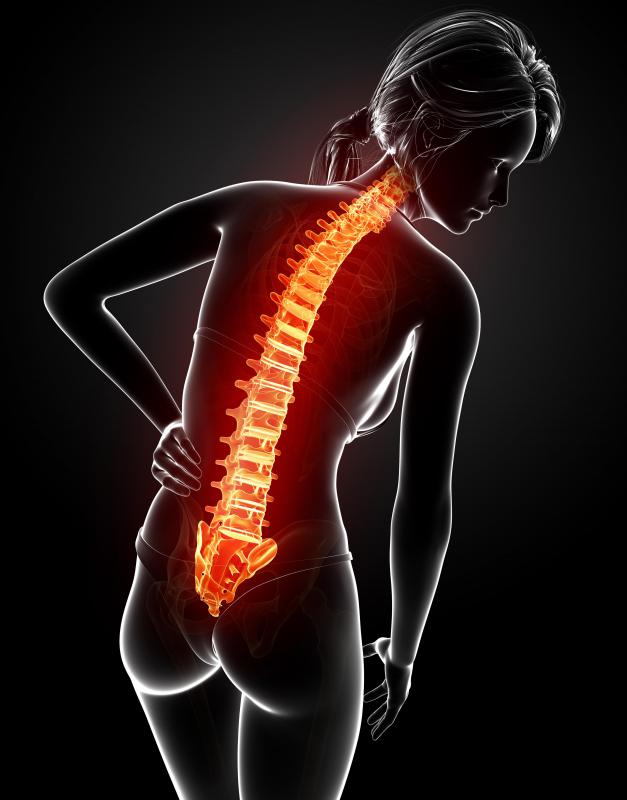At WiseGEEK, we're committed to delivering accurate, trustworthy information. Our expert-authored content is rigorously fact-checked and sourced from credible authorities. Discover how we uphold the highest standards in providing you with reliable knowledge.
What is the Spinothalamic Tract?
The spinothalamic tract conducts the sensations of pain, temperature, itch, and touch from various parts of the body to the thalamus. There are two parts of the spinothalamic tract; the lateral tract and the anterior tract. The lateral tract conducts sensations to the brain and creates sensations of pain and temperature, and the anterior tracts’ impulses are interpreted as pressure and touch.
When a sensation, such as pain or temperature, is conducted through the spinothalamic tract, it arrives in the thalamus and creates an impulse to act. This is what is known as affective sensation. For example, if you are pricked by a pin on your finger tip, the sensation is conducted up through the spinothalamic tract and into the brain, and your brain sends the signal to withdraw from the source of pain in order to reduce it. If you have an itch, the brain sends the impulse to scratch.

A typical pathway of an impulse conducted through the spinothamalic tract begins in the skin, often in the extremities such as the hands or feet. For example, if you get pricked by a pin a neuron, known as a psuedounipolar neuron, connects the skin and the dorsal aspect of the spinal cord. The impulse that comes from the skin goes through these pseudounipolar neurons, and then reaches a secondary neuron, known as a tract cell. These tract cells cross over, or deccusate, to the anterolateral, or frontside, of the spinal cord. From the tract cells, the spinothalamic tract carries the impulse up the spinal cord to the brainstem and to the thalamus, which contains third-order neurons that carry the impulse to several areas of the brain.

Clinically speaking, the spinothalamic tract can be involved in injuries of the spinal cord. Since it deccusates on the level of the spine, it creates different responses than some of the other nerve pathways, which deccusate in the brain. For instance, if there is an injury sustained to the spinothalamic tract, it can create damaged tissue called a lesion. If the lesion is on one side of the spine, there will be loss of the sensations of both pressure and touch below the lesion on that side. Since the spinothalamic tract pathway deccusates on the spine and ascends on the opposite side of the spinal cord, it results in pain below the lesion but on the opposite side of the body, which is known as dissociated sensory loss.
AS FEATURED ON:
AS FEATURED ON:















Discussion Comments
@andee – I had a friend who was injured in the same way. Suddenly, he was in even more danger than before because of his lost sensations below his waist.
He often fell asleep in his wheelchair by the heater. One night, he dozed off with a blanket over his legs. He was too close to the heat, and the blanket caught fire.
He didn't even realize he was burning until the flames reached his torso. By then, his lower body was charred. He screamed, and his wife was able to put out the flames with a fire extinguisher.
Sadly, he died a few days later at the hospital. The fire had done too much damage. If he had been able to feel the heat when it started, he could have put it out in time.
It's astounding how quickly we are able to react to cues about pain and temperature. Look at all the different pathways that the signals have to travel across. It's amazing that we are able to remove our hands from hot surfaces before they burn!
If someone pricks my foot with a pin, I react before they even have time to remove the pin. If I touch a hot pan, I know it before I'm badly burned. It's impossible for my body to sit idly by and let me injure myself.
Our reactions are automatic. We don't have to think in order to remove ourselves from danger.
Something like spinal cord injuries are never good news. My husband works construction building bridges and he had a co worker who was not wearing the proper safety equipment and fell off a bridge he was working on.
His is fortunate to even be alive, but is in a wheelchair. The only type of work he ever knew was construction, so he had to train for a new type of work.
It seems like he did pretty well for awhile, but when something like the spinal tracts and lower motor neurons are affected like that, a host of other problems develop in the future.
For him it seems to be not only a life in a wheelchair, but countless visits to the doctors and hospital for problems relating to this accident.
Having the sensations of pain, temperature and touch is problem something you don't think much about until something like this affects your life.
Just because this man doesn't feel any pain, doesn't mean there aren't things happening in his body that need to be taken care of.
A very good friend of mine was involved in a four wheeler accident and had severe spinal cord injuries from this accident.
He is now paralyzed from the waist down and lives his life confined to a wheelchair. This affected his pain pathways from the waist down and he has no feeling in his legs or any part of his body past the waist.
He was only in his mid 20's when this accident happened, and it has been extremely life changing for him with a lot of hard adjustments.
Post your comments